How to design a happy home office
By being intentional, we can create the conditions for happier, more meaningful, work from home
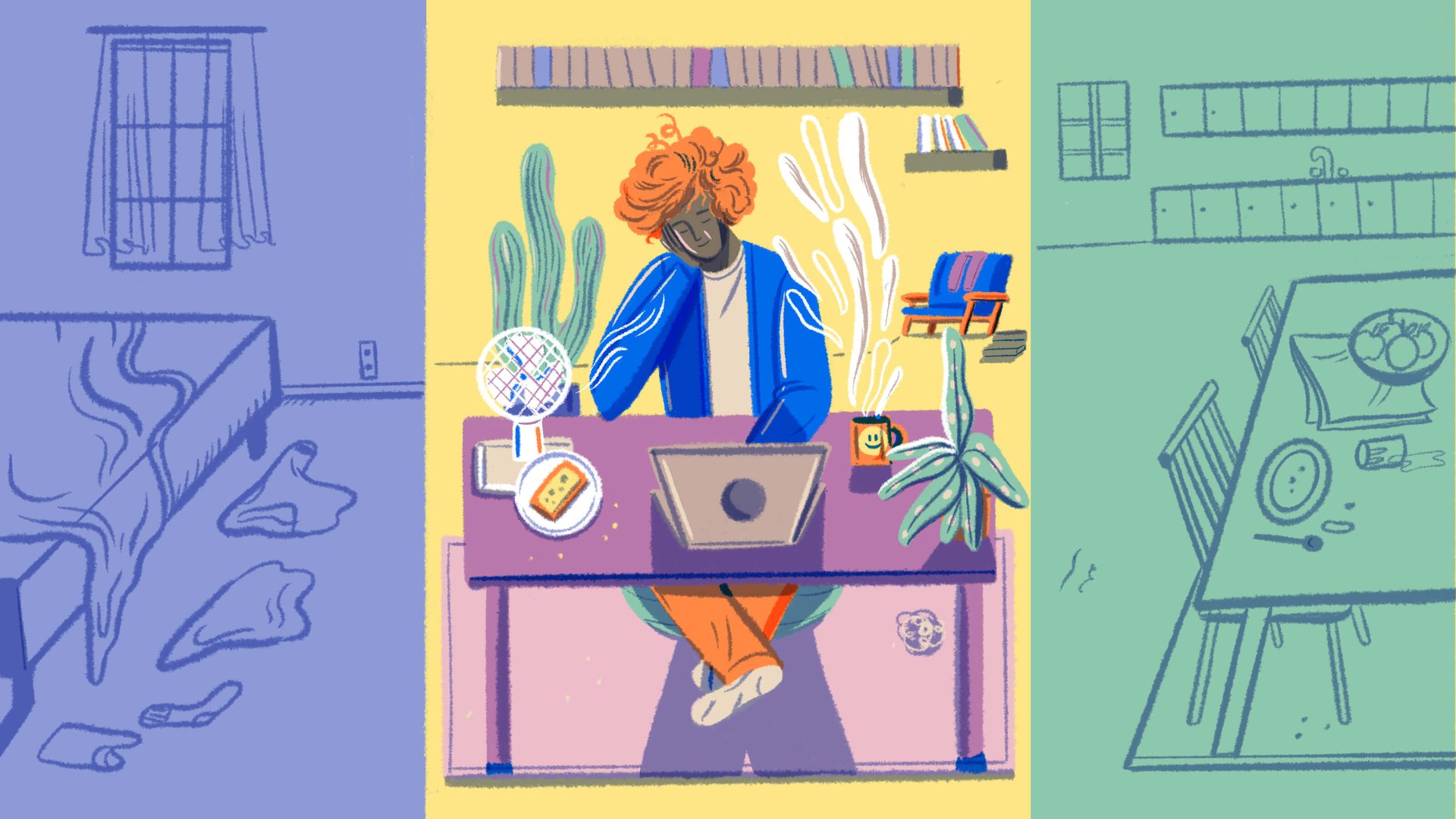

Building a wall between the professional and personal domains has been the fundamental project of the modern worker.
As we face the reality of working remotely for the foreseeable future, many are testing corners of their living quarters—the kitchen table, the bed, the couch, a spare closet, the garden, the garage or even disused swimming pools—in their search for an optimal working spot. In thinking about their coronavirus-era home offices, people are asking: What tools do I need to do my job effectively? How can I stay focused? Does ergonomics really matter? Can I be really happy working at home?
Creating a joyful home office entails a physical and mental makeover. There are many aspiring gurus shilling advice, but there’s no single prescription as our jobs and living situations are vastly different. This field guide attempts to offer a variety of answers to anyone looking to improve their home office setup.

Table of contents
The history of the home office | By the numbers | The market for home offices | The most valuable products (and practices) | The zen of working from home |

The history of the home office
Working from home is a revival of an old idea. Before the Industrial Revolution, the template for residential architecture included a space for doing business. For centuries, English “workhouses” combined a workshop with the family’s living quarters. Farmers lived with their animals in a single-story room called the “longhouse” and merchants often lived above their workshops and storefronts. In the US, middle-class homes typically had a chamber (a.k.a “the den” or a “gentleman’s study”) close to the front door where the master of the house received clients.
The Industrial Revolution shifted the locus of economic activity from the home to factories in Europe and America. A throng of workers, mostly male, clocked-in at a central location to work with machinery and assembly lines. But home-based work didn’t entirely cease during this period. Storekeepers, self-employed artisans, teachers, clergymen, and funeral parlor owners, for instance, continued to live where they worked, as London Metropolitan University’s Workhome Design Guide outlines.
The notion that a home should be a work-free retreat only began in the second half of the 19th century, explains Elizabeth Patton in her new book, Easy Living: The Rise of the Home Office. “Representing human activity in spatial terms, the public sphere was the location for productive labor, while the private sphere became the space for rejuvenation, reproduction, and consumption,” she writes. “The ‘cult of domesticity’ or ‘cult of true womanhood’ established Victorian middle-class homes as the separate, proper sphere for women and for men, a refuge from the hostility, violence, contamination, and strangeness associated with the city and modern life.”
English poet Edgar Albert Best captured this dichotomy in a poem titled “The Home and the Office,” written around 1919. He describes the home as a paradise:
Home is the place where the laughter should ring,
And man should be found at his best.
Let the cares of the day be as great as they may,
The night has been fashioned for rest.
So leave at the door when the toiling is o’er
In contrast, Best portrays the office as a necessary purgatory:
The office is made for the tasks you must face;
It is built for the work you must do;
You may sit there and sigh as your cares pile up high,
And no one may criticize you;
You may worry and fret as you think of your debt,
You may grumble when plans go astray,
But when it comes night, and you shut your desk tight,
Don’t carry the burdens away.
The home office, as we understand it today, resembles what scientist Allan Kinon in 1969 called “dominetics”—a place that combines “domicile, connections, and electronics.” From typewriters and the dawning of residential phone service in the 19th century to the range of portable computers, high-speed wi-fi and collaboration platforms today, technology enables us to do our jobs virtually anywhere—including our homes. In 1967, US broadcast journalist Walter Cronkite concluded his report on the home office by predicting, correctly, that “with equipment like this in the home of the future, we may not have to go to work—the work will come to us.”
But this freedom has a flipside too. Working at home can feel chaotic, especially if we’re operating in cramped quarters or constantly besieged by domestic duties.

By the numbers
29%—Percentage of remote workers in the US who say they struggle with work-life balance
4—Number of extra hours Microsoft employees worked each week during the Covid-19 lockdown
$20.70—Cost of a three-minute call from New York to San Francisco in 1915. Adjusted for inflation, that’s $530 today
$850—Average cost of a fax machine for the home in 1991, that’s $1,600 today
23 hours, 39 minutes—Standing record for world’s longest Zoom meeting
$20,000—Average cost of building a standard 12 x12 ft home office in the US
218 mbps—Average download speed in Singapore, the country currently with the fastest fixed broadband connectivity
3%—Increase in value for a single family home in the US with access to broadband internet prior to the pandemic
100 inches—Diameter of Hugh Hefner’s bed, which doubled as a desk
$24,000—Auction price of a groovy Algeco 1969 pre-fab home office pod

The market for home offices
Forget hardwood floors, marble countertops, or walk-in closets, real estate agents say that building a home office is the wisest home upgrade right now. A recent study by the property referral company Homelight says that homeowners can expect to recoup 87% of their investment at the point of sale.
The most compelling selling point about having a dedicated home office is privacy. Realtors across the US and Canada are already advertising “Zoom rooms”—a conducive space for virtual calls—in their listings. “If you’re going to work from home, especially if you have kids, you’re going to need that extra space,” explained Quebec-based broker Joe Brimo to the Montreal Gazette. “It was cute at first, [when] the dog would bark or the kid would come into the room…But it’s got to the point now where people say, ‘Hey this is a business. Let’s get serious and get the job done.’” Enterprising interior designers like the Washington-DC based studio Residents Understood are already offering Zoom room virtual makeovers, starting at $350.
🎧 For more intel on building an effective home office, listen to the Work Reconsidered podcast episode on office design. Or subscribe via: Apple Podcasts | Spotify | Google | Stitcher.
For those building their dream houses from the ground up, KB Home, a major homebuilder in the US, began offering home offices in their floor plans last month. The customizable rooms are equipped with built-in desks, open shelving, phone jacks, task lighting and lots of charging ports. Working from home, “in a lot of cases, is looking like it may become permanent,” says CEO Jeffrey Mezger. “We think that [the home office] will be a standard part of a house over time.”
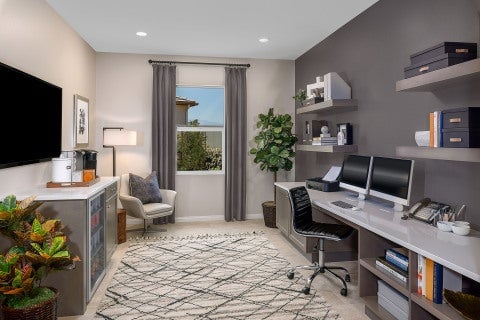
Mezger says including a dedicated home office in stock floor plans signals a significant shift. “What our industry has done for decades is we would merchandise a secondary bedroom as a potential home office,” he explains. “This time, building in a desk with real file drawers and real shelving is different from staging an office.”
German economists are cheering the work-from-home renaissance. Speaking to The Local, Michael Voigtländer, property expert at the German Economic Institute, says it can level the housing market and bolster suburban and rural areas. “Remote working could make a larger area around the city more attractive,” he explained.
All this is contingent on a robust internet connection—the most important utility of decentralized workforces and now the top deciding factor for homebuyers, according to a USA Today report. A 2013 study by the University of Colorado and Carnegie Mellon University established the link between home prices and internet speed. Homes located in areas with broadband access not only sell quicker but also command 7% more in price compared to homes in areas with slower internet speeds.

MVP: Most valuable products (and practices)
Depending on your job and proclivity, a home office set-up can be as sparse or elaborate as you might imagine. The architecture arm of the legendary Italian car maker Pininfarina, for instance, has introduced a prototype for an eight-in-one work-from-home kit meant to serve the needs of wellness-minded remote workers. Packaged in a tube, it unfolds into a laptop stand and includes a small 4K projector; bluetooth speakers with a microphone and a noise cancelation system; LED lights that track circadian rhythms, a handheld air purifier, and even a small desk plant as a nod to biophilic design. (This isn’t Pininfarina’s only foray in designing tools for the office. They’ve also designed an ultra-luxurious office chair priced at $1.5 million.)
A survey of the growing catalog of tools vying for the burgeoning home office market, shows what people are in search of: focus, support, connection, and delight.
Focus

- Noise-canceling headphones: An icon of cacophonous open-plan office layouts, noise-canceling headphones now help us tune out the din of domestic life. New headphones come with smart features that integrate with voice assistants and apps to facilitate work tasks. For instance, Sony’s newest WH-1000XM4 headphones, which some reviewers tout as the “best work from home” model, allow users to connect two devices, have five built-in microphones for better calls, and include a “speak-to-chat” function that automatically pauses the music when you’re speaking.
- Garden work pods, “she-sheds,” and mobile offices: What if you could build an office annex right in your backyard? Pre-fabricated work sheds from companies like Autonomous, Pod Space, and Kit Haus, offer remote workers the possibility of building a cocoon of productivity minus the hassle of a major home renovation. For those without a yard, architects are finding ways to transform vehicles into mobile home offices. One notable Covid-era concept comes from the San Francisco-based firm Vital. The so-called MWU (pronounced “M-wooh”) is a solar-powered passenger van retrofitted with office furniture and the latest work-from-home technology. “Our ah-ha moment came when I was trying to negotiate my own space for an important conference call in April,” explains Nash Hurley, Vital’s principal. “I stole away to my car, parked on the cul de sac in front of my home. When I arrived at my ‘car conference room,’ I noticed two other people on the cul de sac doing the exact same thing—all of us shouting into the air with our heads-free microphones without a hint of embarrassment—happy to be at work.”Parked cars, incidentally, have long served as an instant privacy pod, especially for women in busy housefuls. IKEA’s 2018 “Life at Home” report indicated that 45% of American respondents revealed that they sit in their vehicles to collect themselves
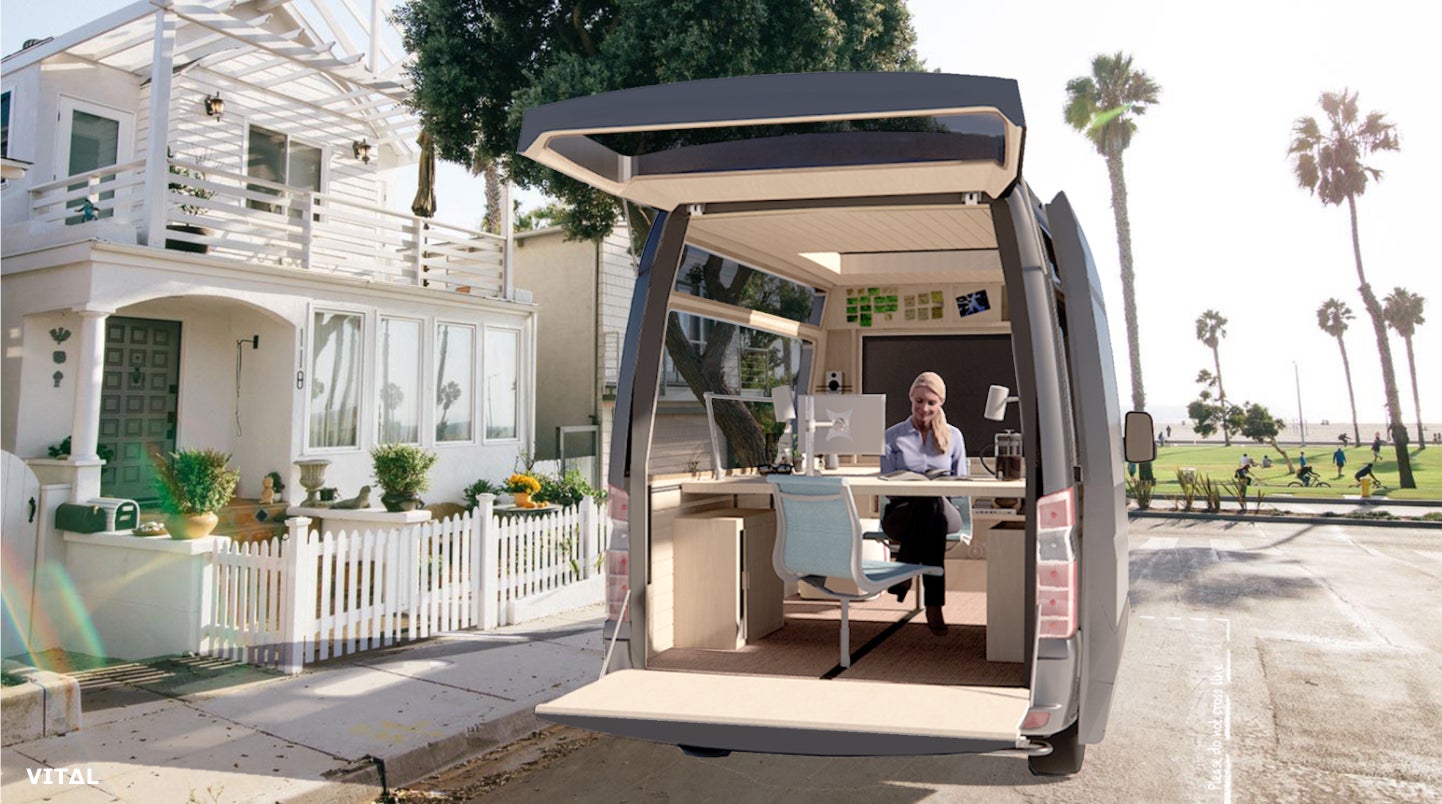
- Meditation: Absent any physical tools, Gopika Setlur, director of the Happiness Center at the Art of Living Foundation says a regular meditation practice can help us create a portable force field from the chaos outside. She says practicing a breathing technique called “SKY breath meditation” can zap away stress that we’ve been carrying throughout the day. “You don’t have to wait for a vacation to feel at peace,” explains Setlur, who learned to meditate in her teens. She has words of consolation for those of us who struggle with being still: “A lot of people think that meditation is this act of not having thoughts,” she explains. “But our minds are active. Sometimes, the more you tell yourself to relax, the more the mind resists.” The capacity for inner quiet is something one can hone over time, Setlur assures. Instead of turning to a meditation app, she recommends seeking a virtual group to practice with and meditating before meals or during our usual office social hour. “When we were in the office, there was that happy hour time. Our bodies wanted to just take a break. Instead of grabbing a beer, just go inward for 20 minutes and see what that does.”
Connection

- Wi-Fi signal boosters: Especially useful for households with several heavy internet users, a wi-fi booster is a simple device that plugs into a wall socket and amplifies your existing signal. For workers who like to move around their house during the day, a wi-fi range extender might also come handy. But these devices work best if you already have a reliable router. If it’s ancient or if you live in a big house with really thick walls, the New York Times recommends investing in a mesh-networking kit that gives you multiple access points through your property.
- A wi-fi blocking chair: On the flipside, ready access to the internet can be utterly distracting. The “offline chair,” a concept from Polish designer Agata Novak, is essentially a wi-fi dead spot in the shape of an armchair. The padded throne offers the sitter a moment to disconnect or focus on a task. It comes with a pocket where one can deposit our mobile device. Similarly, productivity apps like Freedom, FocusMe, and StayFocused block websites and social media to help users remain focused on a task.
Support

- Ergonomic seating: Finding a perfect office chair has become an obsession during the lockdown. The options are plentiful—from mid-century modern classics to gaming chairs—but a design that combines soft aesthetics of residential furniture and full ergonomic support of task chairs remains elusive. If you want to try out a chair or other home office furniture before committing to the big ticket purchase, Feather, a furniture rental start-up, offers several models for a monthly fee.And while designers and engineers are still working on the perfect work from home seating, Kevin Butler, Steelcase’s head ergonomist says the key to preventing back pain is to keep moving throughout the day. Even working from bed is better than slumping on a kitchen table, he explains. “Duration is really correlated to pain. If you can change your posture often, you’ll probably avoid discomfort altogether,” explains Butler, who spoke to Quartz while pacing around in his home in Peoria, Illinois. “The opposite of sitting isn’t actually standing. It’s moving.”
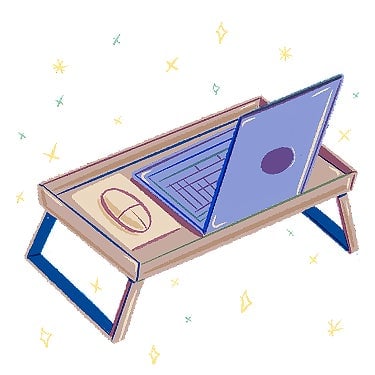
- Blue light-blocking glasses: Staring at computer screens for hours can cause eye strain and headaches. Ophthalmologists recommend wearing glasses that filter out the blue light from electronic devices.
- Lap desk: Useful for anyone who prefers working reclined on a sofa or the bed, a la Marcel Proust, a lap desk is a height-adjustable tray that accommodates a laptop and other work paraphernalia.
Delight

- House plants and (virtual) flowers: A vase of fresh flowers or a potted plant on your desk is one easy way to lift your spirits during the pandemic. Numerous studies over the years suggest that live plants can reduce stress, anxiety, and fatigue. A 2005 Rutgers University study suggests that being surrounded by fresh flowers can even improve concentration and memory.If you’d rather see flowers on the screen, teamlab, Japan’s premiere interactive design collective, recently created ‘Flowers Bombing Home’, a mesmerizing live digital animation composed of hand drawn flowers submitted by anyone around the world.“The novel coronavirus has forced the world to become more isolated, causing people to become confined to their homes,” teamlab explains in a public statement. “This project was created to help us realize that our existence is connected to the world and to celebrate the fact that the world is connected.”
- A can of paint: Changing the color of a room can dramatically alter your perspective. If you’re working in a small, dim spot, the worst thing you can do is paint it white, says Patrick O’Donnell, brand ambassador for the UK paint brand Farrow & Ball. “All you’re doing is making it a drab, gray, whitish space.” Instead, go for paints with a yellow or red undertone, or be bold and choose dark saturated colors O’Donnell suggests. “It works really, really well, but I know for some people that’s a leap of faith.” Brown is an ideal color for a home office, O’Donnell advises. “It’s really relaxing. Imagine oak shelving, neat filing, and house plants…That textural, natural look is really smart,” he says. O’Donnell recognizes how intimidating choosing wall colors can be. He says that if you can’t commit to painting a whole room, you can introduce color through an accent wall or through color-blocking. If your priority is looking good on virtual meetings, choose colors that flatter the skin. His singular advice: “Never follow trends. The most successful spaces are those that represent you.”
- Office white noise generator: If you truly miss the din of corporate life, a free app called “The Calm Office” generates ambient office sounds like the whirr of the air conditioner, the clicking of mouses and keyboards, and the giddy chatter of colleagues. Created by Belgian sound designer Stéphane Pigeon, the interactive app has a virtual sound mixing console so you be the boss of how much white noise you want in your surroundings.

The zen of working from home: Four takes on the optimal home office
A professor from Manila, live from New York, WFH 👩💻 Manhattan, New York
Conducting three university courses for 150 students via Zoom with a 12-hour time difference is no small production. But Ida Anita del Mundo, who is conducting virtual classes in art, film appreciation, and literature for De La Salle University Manila from New York, seems to have quickly mastered the craft. Del Mundo is a filmmaker, a classical musician, and my cousin. Her secret: Prepare for each class like a performance.
“I feel that everything I know about filmmaking and performing has come into play for this,” explains del Mundo. Using her training as a director, she created a mini-studio with ample lighting, camera and sound rig in a corner of her uncle’s apartment in Manhattan where she’s been staying since the coronavirus lockdown began in March. “I ended up setting up with the New York City skyline behind me. On the first day of class, I had to explain to my students that it wasn’t a stock Zoom background,” she says.
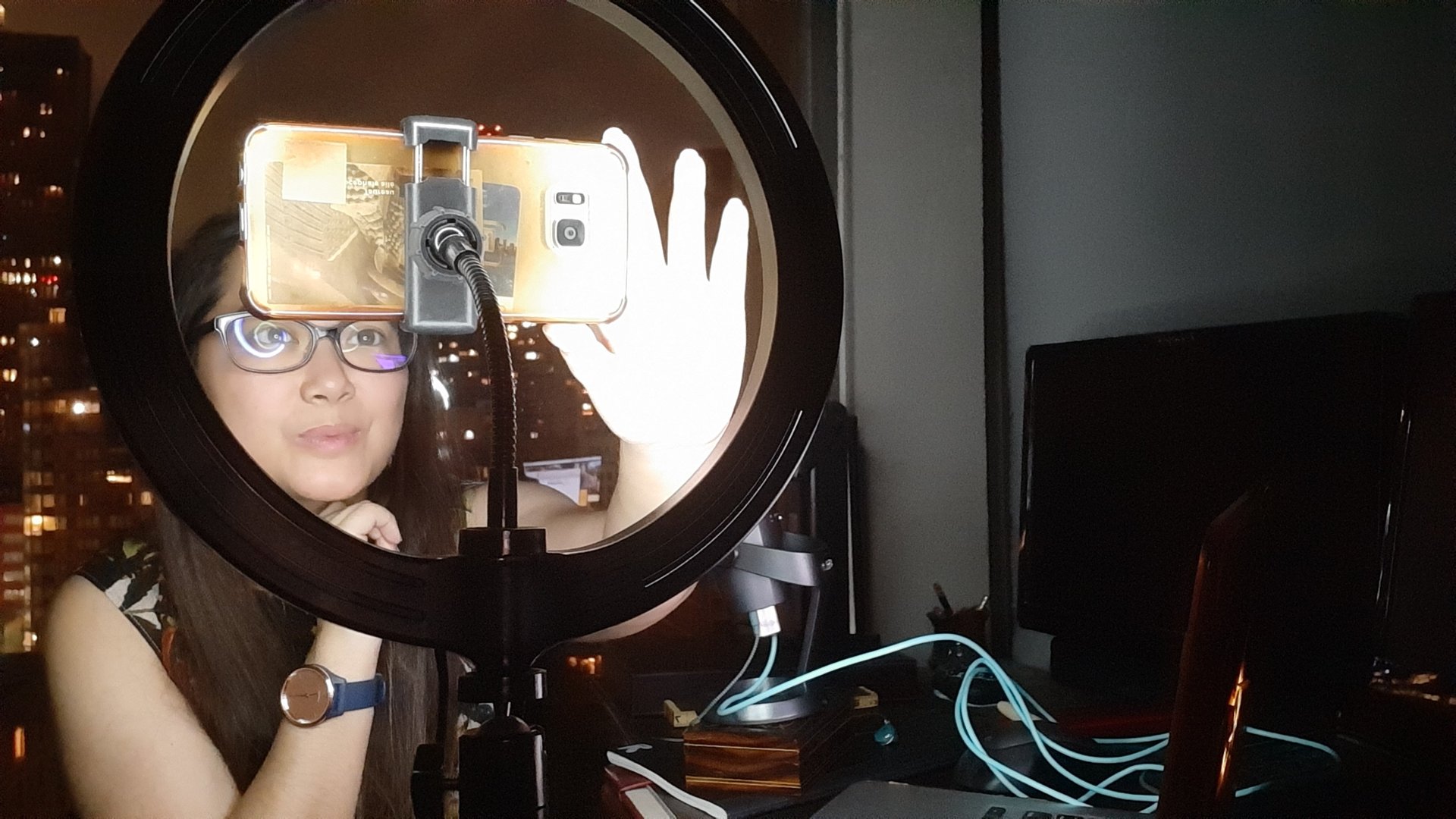
Every week, del Mundo writes a script, prepares slides, and sometimes even produces a lecture video. “Teachers today have to be the research, the scriptwriter, the sound editor, the cinematographer and the talent!” she says. “You realize how much time you need to prepare for these online classes.” She does get a bit of help from her former production manager, who she hired to “produce” her classes.
Del Mundo says she’s learned to dress for the part too. “I seldom wear make-up when I’m teaching in person, but I’m wearing a bit now,” she says. “I realized early on that this was a performance, and people are essentially seeing a close-up.”
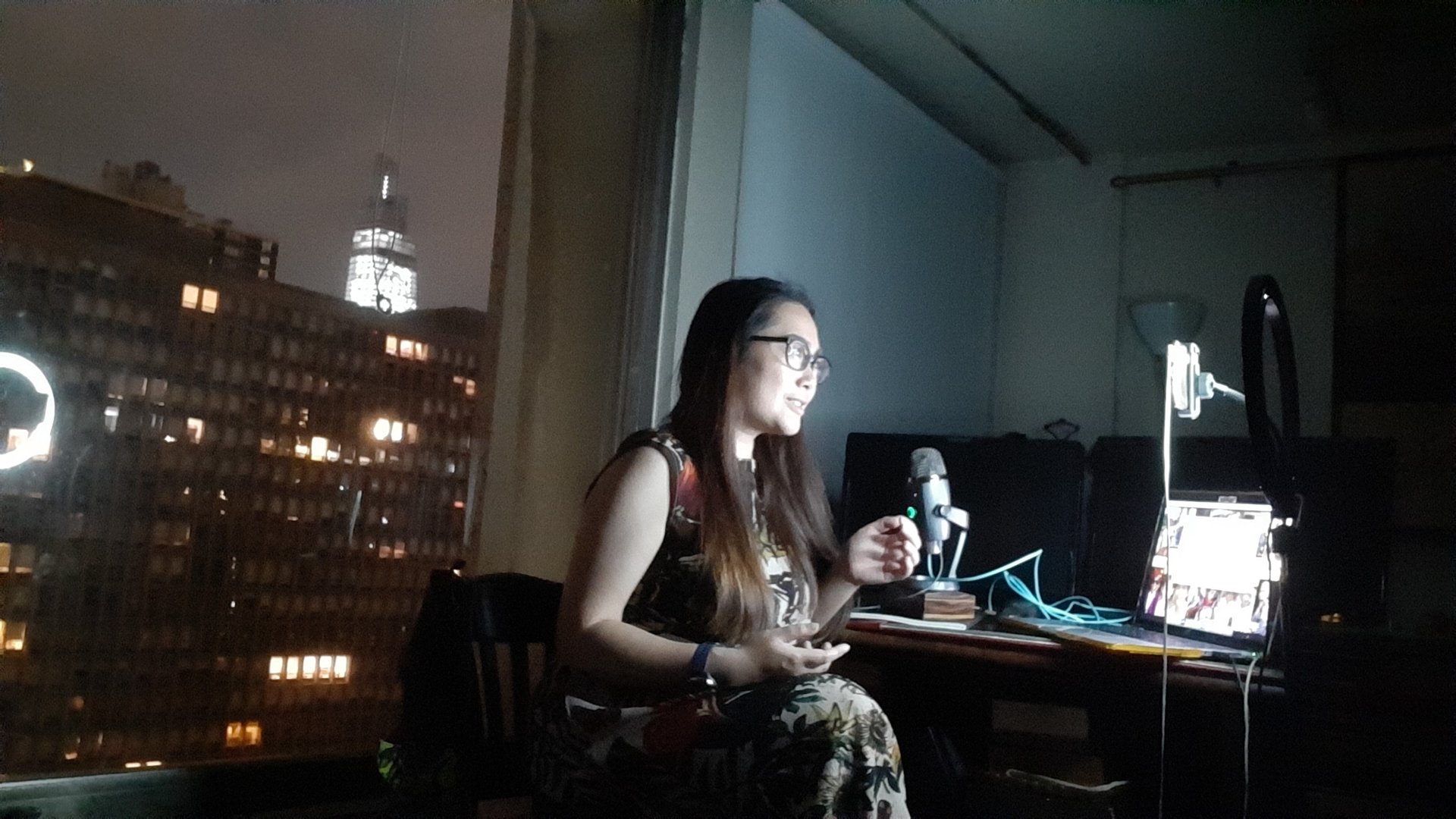
“I think if you’re well-lit, project clearly, and present yourself well, your students see that you’re well-prepared—that you showed up. I believe this helps hold their attention,” she notes. Being transparent about her unexpected predicament and the fact that she’s appearing in the wee hours of the morning also helped establish a rapport with her students,” del Mundo says. “That really set the tone. Perhaps that’s why they’re quite engaged—or at least I like to think so. They know that I’m staying up for them. I’ve been anxious that it would be hard to transition online, but they’ve been really great.”
A business owner attuned to neurodiversity, WFH 👩💻 Miami, Florida
When Covid-19 cases began peaking in late March, Alex Daly, founder of a communications and marketing firm in New York City, decided to relocate to Florida and be with her parents. With partner Hamish Smyth, Daly took a few suitcases, their laptops, computer monitors, and strapped her office chair in the back seat of a sedan to make the 18-hour drive south.
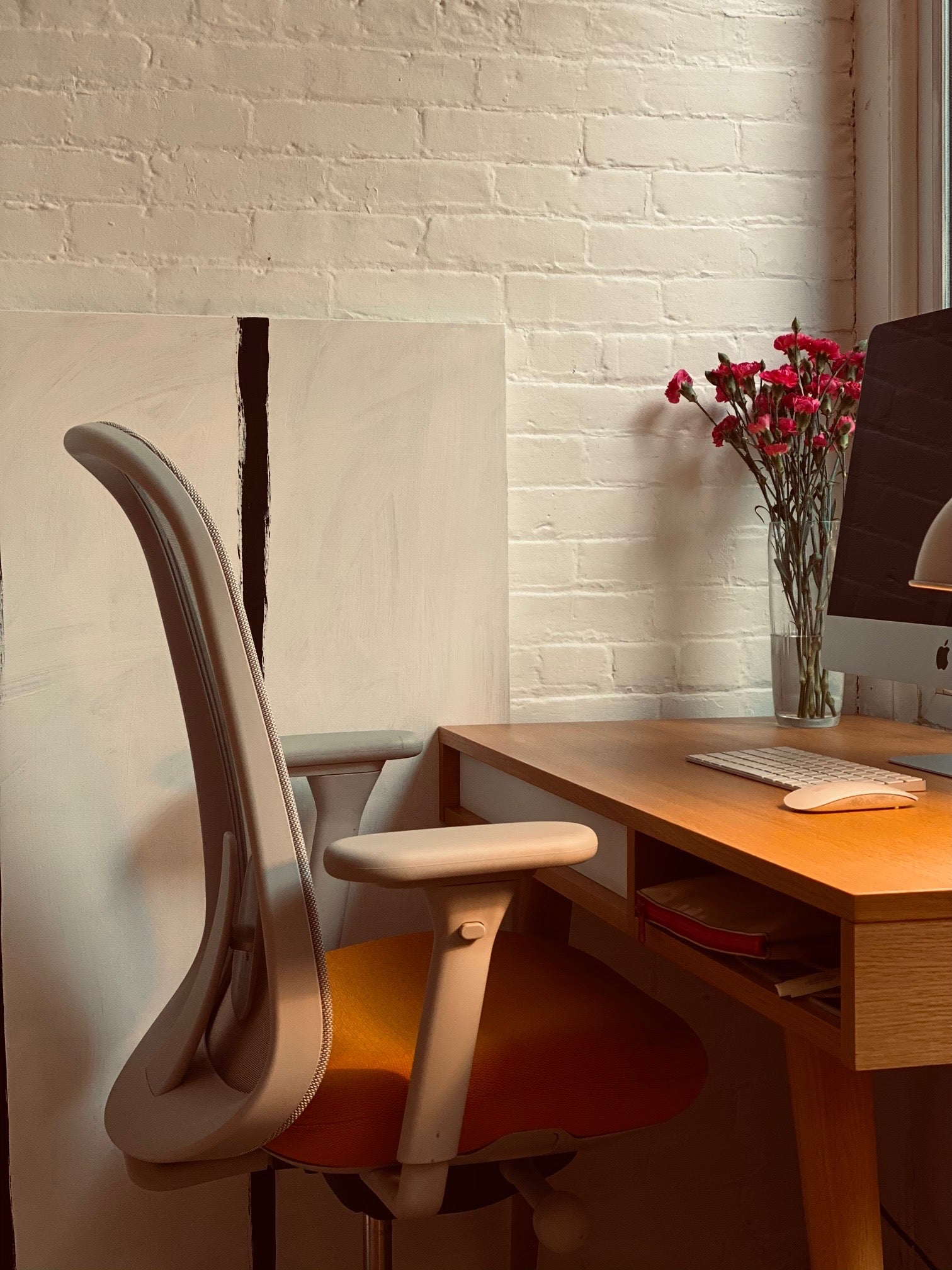
Diagnosed with obsessive-compulsive disorder in 2017, Daly says it was crucial to maintain a sense of order, especially during the most stressful scenarios. Once in Miami, she quickly created a proper home office in a spare room next to her childhood bedroom. “My parents both own their businesses and they both have their respective workspaces. It was almost like we were in a co-working space in my parents’ home.”
“Some people think that it’s very strange or funny that I brought my own chair,” she says. “But it was important for me to create this environment that felt really safe and that felt like an office. I think it was to create some level of control during this really insane environment we’re currently living in.”
Establishing a routine helps, too. Daly begins each day with exercise before diving into work at 9:30 am. She fits in an afternoon walk often while taking phone calls, and tries to hit 5,000 to 10,000 steps a day. At the end of the work day, she and Smyth jump in the car and drive aimlessly for 45 minutes. “We put on some music or a podcast, we roll down the windows,” she says. “It’s been so helpful for clearing my head. It’s nice to feel like you’re returning home at the end of it and makes things feel less like Groundhog Day where days just blend together.”
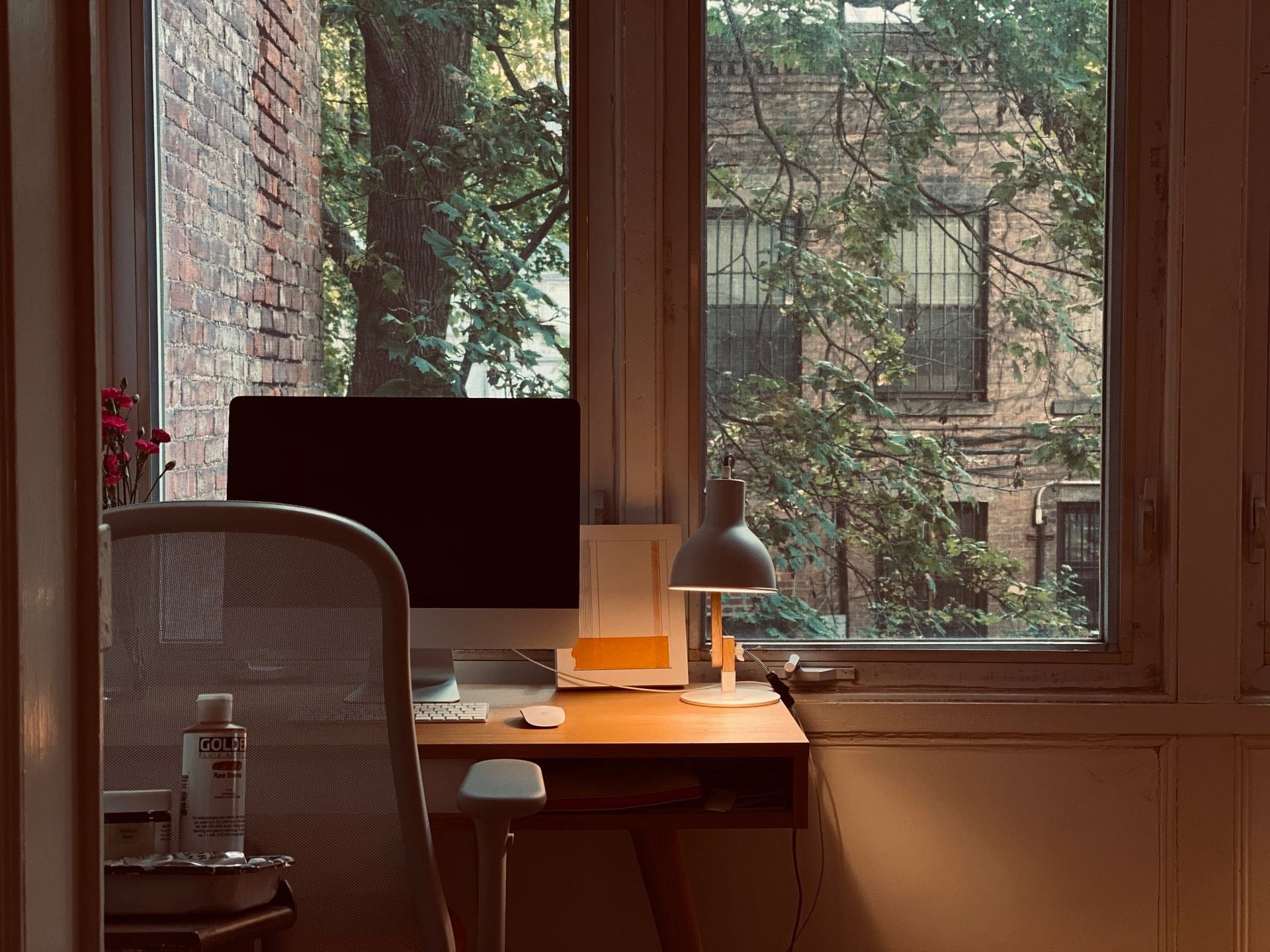
Daly adds that attending to her mental health and thinking about neurodiversity has made her more attuned to her team’s anxiety levels. “Managers and leaders who struggle with mental health who work on themselves can create a higher sense of empathy,” she explains, “I feel that I’ve been a little bit more aware of what my team needs.”
Juggling a consultancy and two kids, WFH 👩💻 Lancaster, South Carolina
There’s no such thing as a regular schedule for Liza Morris. The founder of Alkemi Group, a science communications consultancy in Washington, Morris’s days are largely shaped by the needs of her two young children and her clients, who at times, are in a different time zone.
“I try to get some exercise on the days I can squeeze that in before the kids get up. Then, there’s the care and feeding of small humans. It’s just kind of balancing back and forth,” she says. Sometimes that entails working 18-hour days.
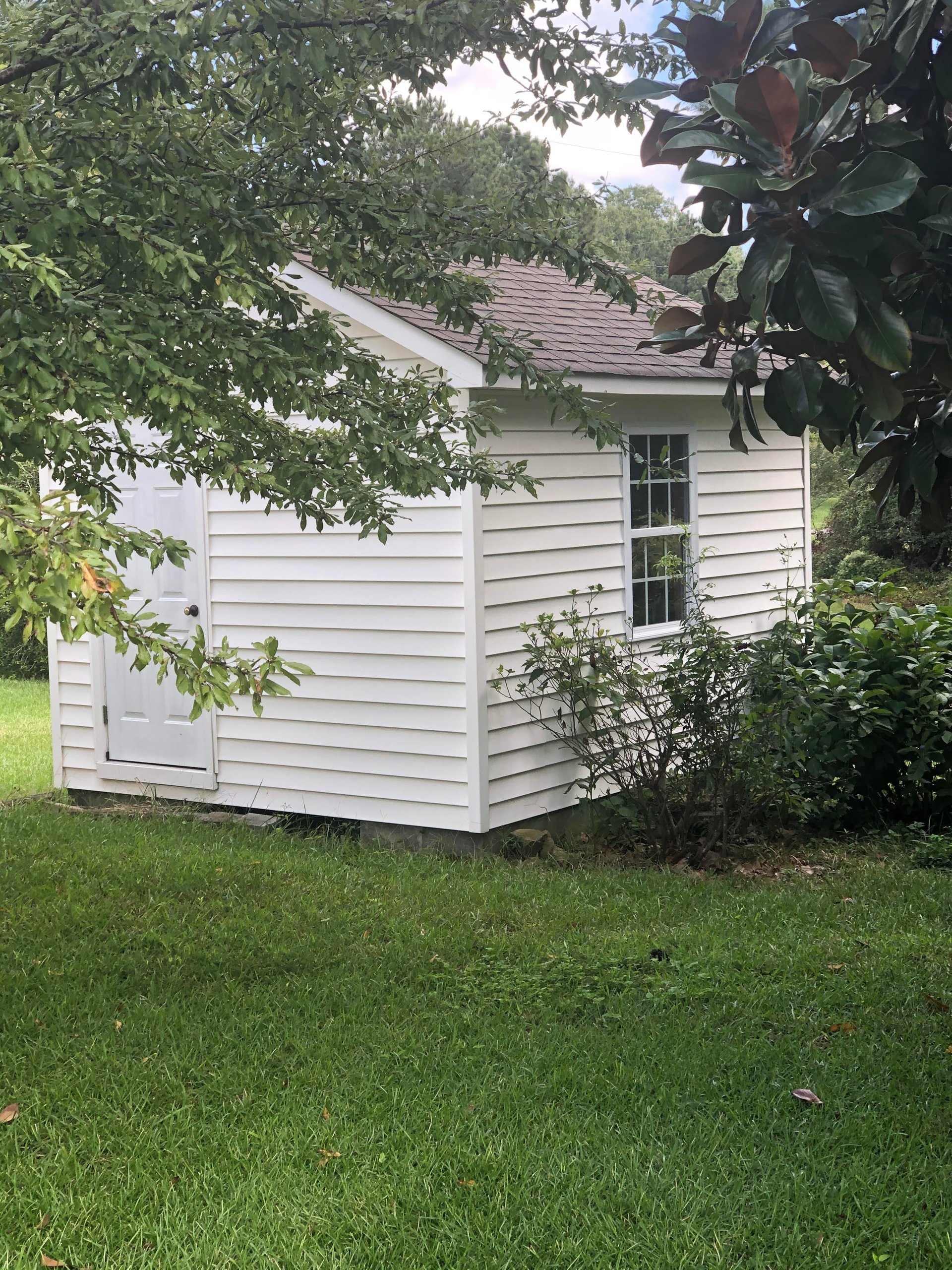
The pandemic has made things even more onerous. With both kids homeschooling, Morris says it’s harder to get blocks of focused work. “I feel like I am working all the time, because it’s harder to get things done because there are a lot of distractions,” she says. A self-described extrovert, she says working at home isn’t her preferred scenario. Before the pandemic, she often worked on site in her clients’ offices, and felt energized by reporting to an office.
During the early months of the pandemic, Morris, her husband, and her two children decided to move in with her mother in South Carolina. She feels indebted to her mother who is not only helping with child care duties but also relinquished most of the house to them. She even gave up her bedroom, so Morris can set up a home office in a quiet part of the house. Even then, privacy is hard to come by, Morris says. She tells the story of how her toddlers somehow managed to break the door lock several times: “If I had a call that needed privacy, I would just turn go in the bathroom, turn on the fan, and take it there,” she explains. Morris is mulling moving her operations to a backyard shed which her grandfather once used as an office.
How does she find joy during such a hectic time? “It’s hard to not be joyful when you’re around small kids,” she says, noting that she’s decorated her makeshift office with their drawings. Being close to nature has also been a blessing. “I’ve watched a lot of baby birds grow in the last few months,” Morris explains. “I actually fed a hummingbird out of my hand the other day.” Last month, she also kept a rescue kitten in her desk drawer until finding someone to adopt it.
“Every time I start feeling sorry for myself, I just have to remind myself that I have it so much better than so many people right now…My mom is a retired music teacher and she’s teaching both of the kids piano. It’s the best Covid bonus ever,” Morris says. “I have client work, I have my mom helping us, I can’t complain.”
A startup CEO and champion remote worker, WFH 👨💻 Madrid, Spain
Give Suraj Sudhakar a laptop, silence, and some snacks and he can be productive anywhere. The founder and CEO of CoolCoach, a wellness-focused social enterprise headquartered in Pune, India, says the key is learning what kind of work style you thrive in.
Early in his career as a computer engineer, he often finished his tasks before heading to the office. “I realized that going into the office was unproductive for me if I didn’t have meetings,” says Sudhakar who spoke to Quartz perfectly situated in his brother-in-law’s empty apartment in Madrid. “I learned that I prefer big chunks of time at one goal to get work done.”
Reading Paul Graham’s essay titled “Maker’s Schedule, Manager’s Schedule” was eye-opening, says Sudhakar. In his 2009 essay, Graham, who is best known for founding the startup accelerator Y Combinator, outlines how managers can feel productive by dividing their day in small increments, for meetings and check-ins. Makers, on the other hand, need chunks of uninterrupted time to get their work done. In running his startup, Sudhakar has learned to manage his calendar based on the type of task he has to tackle that day.
As much as he champions remote work, Sudhakar recognizes that some workers thrive best when surrounded by others in a bustling office. “You need different structures, different environments to make different people productive,” he says.
Sudhakar suggests that the months of forced remote work can be a rare chance to experiment and discover our own work styles, and in doing so, have more agency over our happiness. “Many people have not had the chance to have a separate set-up,” he points out. “When you join a workforce you’re expected to go to the office and, whether you like it or not, you build your life around it.”

More than ever, it’s become clear that the established templates for office architecture—from open-plan layouts to cubicle farms—need a rethink. A home office, in essence, offers a testing ground for figuring out how, where, and when we do our best work. As stressful as it is to upend our 9 to 5 routines, this year presents a rare opportunity to experiment with new configurations. And when we’re finally able to report back to our old desks—even on a part time basis—we’ll hopefully have more agency to tailor the space where we spend most of our day.